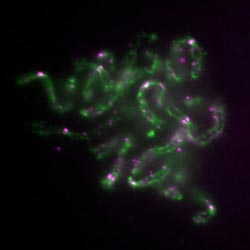Shaping up for cell division

Figure 1: Mitotic chromosomes assembled in the Xenopus cell-free system. Condensin I (green) and II (magenta) display distinct localizations within the chromosomes. <br>Copyright : 2011 Tatsuya Hirano <br>
The shape of chromosomes is determined by the relative levels of key protein complexes, research conducted by Keishi Shintomi and Tatsuya Hirano of the RIKEN Advanced Science Institute has shown.
As a cell prepares to divide via the process called mitosis, chromatin—the material in which DNA is packaged—condenses to form discrete rod-shaped structures called chromosomes. Each chromosome contains duplicated chromatids—sister chromatids—that are aligned in parallel. After ‘mitotic chromosome condensation’ is complete, the paired chromatids segregate such that each daughter cell receives one of each pair.
“For well over a century, biologists have noticed that the shape of condensed chromosomes is highly characteristic, but varies among different organisms or among different developmental stages in a single organism,” explains Hirano. “We are interested in understanding how the shape of chromosomes is determined at a molecular level.”
Hirano’s group previously discovered that mitotic chromosome condensation requires the action of two protein complexes, known as condensins I and II. This group and others have shown that a third protein complex called cohesin is responsible for the pairing of sister chromatids within a chromosome.
To test exactly how condensins and cohesin may contribute to shaping of chromosomes, Shintomi and Hirano turned to a cell-free system based on extracts prepared from the eggs of the frog Xenopus laevis. “The Xenopus system perfectly suited our purposes because it enables us to recapitulate many chromosomal events, including chromosome condensation, in a test tube in a cell-cycle regulated manner (Fig. 1),” says Hirano.
To achieve their goal, the researchers then had to develop a series of sophisticated experimental protocols to precisely manipulate the levels of condensins I and II and cohesin present in the extracts.
Under the standard condition, chromosomes assembled in this cell-free system tended to be long and thin, which are general characteristics of chromosomes observed in early embryos. Strikingly, however, when the ratio of condensin I to II was reduced, they became shorter and thicker, being reminiscent of chromosomes observed in later stages of development. Further experiments revealed that cohesin works with condensin I and counteracts condensin II to properly place sister chromatids within a chromosome. Thus, their actions can be likened to a molecular ‘tug-of-war’.
“Our findings demonstrated that chromosome shape is achieved by an exquisite balance between condensin I and II and cohesin,” says Hirano. “Such a concept had been suspected for a long time, but has never been demonstrated so beautifully and convincingly until now.”
The corresponding author for this highlight is based at the Chromosome Dynamics Laboratory, RIKEN Advanced Science Institute
Shintomi, K. & Hirano, T. The relative ratio of condensin I to II determines chromosome shapes. Genes & Development 25, 1464–1469 (2011).
Media Contact
All latest news from the category: Life Sciences and Chemistry
Articles and reports from the Life Sciences and chemistry area deal with applied and basic research into modern biology, chemistry and human medicine.
Valuable information can be found on a range of life sciences fields including bacteriology, biochemistry, bionics, bioinformatics, biophysics, biotechnology, genetics, geobotany, human biology, marine biology, microbiology, molecular biology, cellular biology, zoology, bioinorganic chemistry, microchemistry and environmental chemistry.
Newest articles

Superradiant atoms could push the boundaries of how precisely time can be measured
Superradiant atoms can help us measure time more precisely than ever. In a new study, researchers from the University of Copenhagen present a new method for measuring the time interval,…

Ion thermoelectric conversion devices for near room temperature
The electrode sheet of the thermoelectric device consists of ionic hydrogel, which is sandwiched between the electrodes to form, and the Prussian blue on the electrode undergoes a redox reaction…

Zap Energy achieves 37-million-degree temperatures in a compact device
New publication reports record electron temperatures for a small-scale, sheared-flow-stabilized Z-pinch fusion device. In the nine decades since humans first produced fusion reactions, only a few fusion technologies have demonstrated…





















